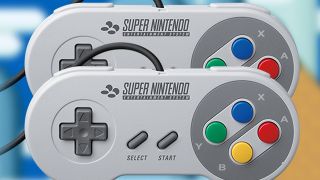Should you buy a SNES Mini? Nintendo’s new retro console, the diminutive follow-up to last year’s sell-out, miniature NES hardware, is out in just a couple of days. Similarly, the 16-bit collection in-a-box is already selling out on pre-order, thanks to its authentic (if shrunken) hardware and generous line-up of 21 pre-installed games. But is it worth the early enthusiasm?
Is it genuinely this autumn’s must-buy, or just a nostalgia-baiting shell, filled with faddish fun and ultimate, dust-collecting disappointment? Well you don’t need to wait until the SNES Mini release date of September 29 to find out, because we already have one in the office, and have been tinkering around with it for quite a while now. My findings, from hardware quality, to ease of use, to the all-important matter of games, can be found below. So read on. And if you like what you read (Spoiler: You might), you can try for a SNES Mini pre-order at the links below:
SNES Mini pre-order, Amazon UK
SNES Mini pre-order, Amazon US
Setting up
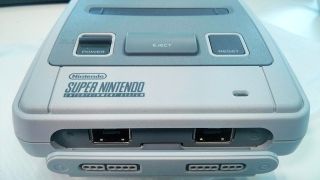
Getting the SNES Mini rolling could not be easier if a Nintendo engineer came around to your house in the middle of the night and did it for you while you slept. Okay, technically that would be easier in terms of set-up, but what if the engineer woke you up, and then you had to make them a cup of tea out of polite obligation at 3am? That wouldn’t be easy at all.
But setting up the SNES Mini is. There’s a just an HMDI cable to attach to your TV, and a USB-to-micro-USB power cable. No plug adaptor, alas, but with a standard USB on the power end, the cable will draw juice from pretty much anything. And that’s it. You plug in two cables, attach a controller or two, and switch on.
Hardware
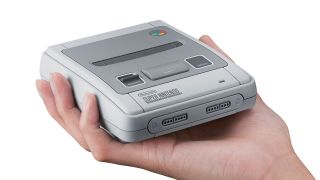
In terms of design and build quality, the SNES Mini is such a delight that I could goddamn hug it. The console itself is a perfectly downsized recreation of the original, like the world’s classiest, highest production-value Happy Meal toy. There’s none of the degradation in detail you’d expect from the quarter-sizing of a 25 year-old console. From curves, to grooves, to buttons, to the cuts between panels (pleasingly, the SNES Mini’s shell is built from – almost – the same number of parts as the original console, rather than being a cheaply moulded approximation with ‘fake’ surface details), the case feels every bit as premium as the Super NES did on launch in 1991. I know, because I was there, and still have two original machines in my house. This thing is a gloriously affectionate piece of design.
The differences? Only a couple. Most sadly, while the delightfully, authentically clunky Power switch and tactile, clicky Reset button work just as they ever did, the Eject button is just for show. It’s not actually a button at all. A small tragedy, given the wonderfully spongy yet strangely hefty fun of the original. Okay, there’s nothing to actually eject this time around, but who cares? Just pressing it was half the point.
Similarly, while nicely detailed as a separate plate, the cartridge slot cover doesn’t do anything. No major problem though, obviously.
As for the controllers, they now use a new, chunkier port style, revealed by pulling off the whole, original controller plug façade. The pads themselves are a 100% spot-on recreation though, right down to the slightly rough texture you used to get on box-fresh SNES controllers, before your game-eager hands buffed them to a fine polish. It would have been nice if the controller leads had been extended this time around, as the SNES Mini’s hand-to-console tethers now feel a tad restrictive. Great for recreating the ‘sitting on the floor in front of the TV’ world of early-‘90s gaming, but not quite as comfortable as 2017 expects. No-one assumed wireless SNES controllers would be incoming, but an extra couple of feet of cable would have been nice.
Features and operation
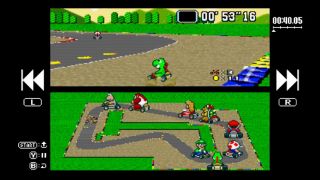
Simple but effective. That sums up the SNES Mini. Emulating the instant, plug-and-play ease of 16-bit cartridge gaming as well as one can with 21 games built in, it keeps the system menu as neat and straightforward as can be. All the games appear in a scrollable row, which can be re-ordered by several criteria such as release date, publisher, title, etc. Up top are quick links to display settings, general settings, and a QR code for downloading game manuals to your smart device.
Below, you’ll find a chunky, pull-up menu containing save-state slots (four for each game) that generate automatically when you drop back to the main menu using the Reset button. Finally, the SNES’ right-hand finger-presser has a real, functional use beyond creating attractive symmetry on the case. But rather than simply giving you a handy, instant save-point, these states can also be rewound and fast-forwarded, in order to pick up exactly where you want (probably just before royally messing up that last corner in Super Mario Kart). At the same time, any game that originally launched with battery back-up comes with its on-board save facility preserved, and highlighted in its slot on the main menu.
If I have any niggle here, it’s that it would be really nice if there was a way to reset to the menu without having to physically reach over and press the button on the console (some kind of obscure button macro could have been added without having to remodel the controller). Obviously an oversight rather than a deal-breaker, but it does feel like rather a missed opportunity. And while we’re on negatives, I need to raise the point that while playing last night, I did experience an audio drop-out and aspect ratio jump that persisted after a reset. A quick console power cycle, and a manual ratio switch on my TV fixed the issues, respectively (and the latter could have been the fault of my TV getting confused by the various resolutions in play, rather than the SNES Mini itself), but I’d be remiss not to raise this. These things only happened once during several hours' play, but it might be worth keeping an eye (and ear) out.
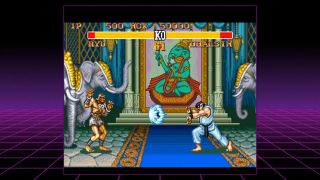
As for those display settings I mentioned? You get three graphics filters, and a whole bunch of display frames with which to fill out the screen space around the square, standard-def game space. Filters-wise, you can choose between crisp-displaying versions of 4:3 and the more accurate, squarer, ‘Pixel perfect’ setting, which displays the games at a 1:1 pixel ratio without any horizontal stretching. The third one is the inevitable, CRT emulation mode, which filters your games to look like they’re running on an analogue, standard-definition TV. Ordinarily I pass these modes off as gimmicky nostalgia, and they usually are, all over-exaggerated scanlines and artificial fuzz. The SNES Mini’s version though, is actually really good, doing a brilliantly authentic job of recreating just how these games looked and felt during their original release.
And it’s not just a novelty. Certain titles suffer slightly through their sharper, cleaner, modern reproduction, the standard-definition blurring that made their original pixel art appear smooth and rounded now missing. In some cases, it becomes quite apparent that certain art design was crafted with such softening in mind, and the CRT mode works miracles in restoring these visuals, ironically, through lower fidelity.
Donkey Kong Country in particular - its art made of 16-bit scans of high-res, CG renders - benefits greatly, and Super Metroid is a great deal more atmospheric and cinematic with its sharp pixels blended under a layer of grimy fuzz. Coupled with the game's oppressive, sci-fi horror vibe, the CRT filter gives a feel not unlike a formative, early '90s watching of Aliens on a grotty VHS tape. You’ll likely use this mode on a case-by-case basis, but it’s very nice that it’s here, and so relatively quick to access. Though again, some means of doing this from in-game would have been a pleasant addition.
Games line-up
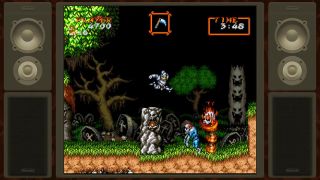
I really wasn’t prepared for how impressive, thoughtfully curated, or ambitious the SNES Mini’s game line-up was going to be. Far from the quick and easy, obvious nostalgic-fest it could have been, its selection reads like a ‘What? Really!?’ cross-section of the era’s best and most important, even stepping away from the mainstream a couple of times to ensure it snags the games that matter. The full line-up? *deep breath*
Super Mario World. Donkey Kong Country. F-Zero. Super Castlevania 4. Super Mario Kart. Super Metroid. StarFox. Super Mario RPG. Super Ghouls ‘N’ Ghosts. Super Punch-Out. Mega Man X. The Legend of Zelda: A Link to the Past. Kirby’s Dream Course. Kirby Super Star. Yoshi’s Island. Contra 3. Street Fighter 2 Turbo. Earthbound. Secret of Mana. Final Fantasy 3 (aka Final Fantasy 6). Star Fox 2.
An important point to note before we go on. Not only is that a stunning selection of games, but several of them (several of the very finest, in fact) were never released in Europe the first time around. Unless they’ve picked them up on a recent Nintendo machine’s Virtual Console service, this is likely the first time a lot of EU players will have had access to Earthbound, Super Mario RPG, and the original SNES version of Final Fantasy 3(6). I could rave forever over the last one alone. It remains the pinnacle RPG on a console famed for an all-time great RPG line-up, and one of the best in the Final Fantasy series to date. To get it alongside the others (and Secret of Mana, the best action-JRPG of the era, and still one of the most visually and aurally beautiful pixel-art games ever made) in one package is an unbelievable proposition.
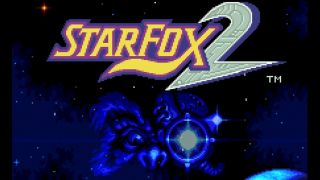
Also, Star Fox 2. Star Fox 2 was never released. Anywhere. This is the bona fide world premiere of a forgotten, near-mythical video games legend we’re talking about here. Is it actually good though? I answer that question in full in my complete review (because after waiting 20 years, it deserves one), but the nutshell contains the words "Yes" and "No".
Even ignoring how much time has passed since its premature polygon pushing was state of the art, StarFox 2 is a decidedly weird sequel. Escewing the first game's multi-threaded, 13-stage campaign structure in favour of a single, small, nonlinear space-map peppered with bite-sized engagements and small, free-roaming encounters, it is not at all the game you are expecting. Rather than a focused, space-shooter follow-up, it's really a pseudo-XCOM, strategic warfare game, with time and resource management its primary concerns, and a short, iterative play-time intended for speed-running and time attack.
It's a very interesting game, but not always successful, its ambition and imagination clearly outreaching its technical limitations. But it is definitely worth playing, if only to see the real introduction point of certain elements that later became staples of the series.
Games quality

The other thing I really wasn’t prepared for is just how well the majority of these games hold up today. And I’m not talking in that begrudging, rose-tinted way in which we usually have to quietly make age-allowances for retro collections. By hand-picking the best of the early to mid-‘90s, Nintendo has curated a barrage of finely crafted, utterly precise, very impressively engineered 2D game design that remains vital regardless of its era. And on the subject of competing eras, it’s now pleasingly apparent that the modern age of gaming has actually done these games a few favours.
With contemporary indie so often appropriating and riffing on the design conceits and aesthetic of 8-bit and 16-bit gaming, frequently via more complex evolutions, it actually now feels really great to get back to the source, and enjoy the purity of game design that inspired (and in many cases still stands up to) its modern descendants.
Moreover, some of these games – particularly the harder ones – are even more playable now than they were a few years ago. Going in, I feared in a few cases that I’d fall victim to ‘Old man who’s not as good at games as he was when he was 12’ syndrome, but actually, the opposite is the case. Having enjoyed a great many recent games that play with (often exaggerated) perceptions of 16-bit gameplay and difficulty, it turns out that a lot of these originals now feel completely at home in 2017.

After playing Hotline Miami and Super Meat Boy, the notorious likes of Contra 3 and Mega Man X no longer feel like the punishing, retro horrors they once did, but rather fun, fair, lean and clever slices of legitimate game design every bit as at home in the modern era as they were 20 or so years ago. By riffing on nostalgia, modern indie games have actually washed away the nostalgia factor from these originals by naturalisation, so whether you’re an original-generation Nintendo kid or a new initiate intrigued by how things were during the company’s '90s glory days, you’ll likely feel a lot more at home than you expected, a lot faster.
Not every game stands up this well, of course. Super Castlevania 4, for instance, although dripping with mood and cool visual effects, now feels rather stiff in the mechanics department. StarFox, as a very, very early 3D game, is rather chuggy, although it's certainly still playable, and runs a tad better than its more technically ambitious sequel.
And while still a brilliant, casual-friendly fighting game, Street Fighter 2 Turbo naturally doesn't match up to the nuance of SF5. But on the whole we’re looking at gameplay that’s decidedly timeless, rather than charmingly of-its-time. It says everything that, with a PS4 sitting under my TV loaded with great games, right now I’m most excited about taking the SNES Mini home again tonight, replaying long-missed classics, reacquainting myself with games I perhaps didn’t fully appreciate upon their release, and discovering a bunch of new friends that I missed the first time around.
